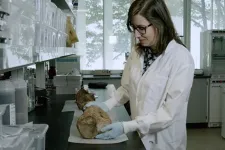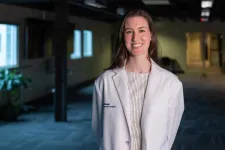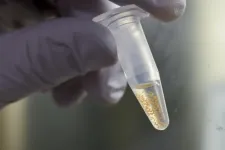(Press-News.org) Ever since we learned that the surface of planet Mars is cold and dead, people have wondered if there is a way to make it friendlier to life.
In a groundbreaking study published Aug. 7 in Science Advances, researchers from the University of Chicago, Northwestern University, and the University of Central Florida have proposed a revolutionary approach towards terraforming Mars. This new method, using engineered dust particles released to the atmosphere, could potentially warm the Red Planet by more than 50 degrees Fahrenheit, to temperatures suitable for microbial life—a crucial first step towards making Mars habitable.
The proposed method is over 5,000 times more efficient than previous schemes to globally warm Mars, representing a significant leap forward in our ability to modify the Martian environment.
What sets this approach apart is its use of resources readily available on Mars, making it far more feasible than earlier proposals that relied on importing materials from Earth or mining rare Martian resources.
This strategy would take decades. But it appears logistically easier than other plans proposed so far.
“This suggests that the barrier to warming Mars to allow liquid water is not as high as previously thought,” said Edwin Kite, an associate professor of geophysical sciences at the University of Chicago and corresponding author on the study. The lead author was Samaneh Ansari, a graduate student in Prof. Hooman Mohseni's group at Northwestern University.
Astronauts still won’t be able to breathe Mars' thin air; making the planet suitable for humans to walk on the surface unaided requires much more work. But perhaps groundwork could be laid, by making the planet habitable for microbes and food crops that could gradually add oxygen to the atmosphere—much as they have done for Earth during its geologic history.
A new approach to an age-old dream
There is a rich history of proposals to make Mars habitable; Carl Sagan himself came up with one back in 1971. These have ranged from outright daydreams, such as science fiction writers depicting turning one of Mars’ moons into a sun, to more recent and scientifically plausible ideas, such as engineering transparent gel tiles to trap heat.
Any plan to make Mars habitable must address several hurdles, including deadly UV rays and salty soil. But the biggest is the planet’s temperature; the surface of Mars averages about -80 degrees Fahrenheit.
One strategy to warm the planet could be the same method that humans are unintentionally using here on Earth: releasing material into the atmosphere, which would enhance Mars' natural greenhouse effect, trapping solar heat at the surface.
The trouble is that you would need tons of these materials—literally. Previous schemes depended on bringing gases from Earth to Mars, or attempting to mine Mars for a large mass of ingredients that aren’t very common there—both are costly and difficult propositions. But the team wondered whether it could be done by processing materials that already exist abundantly on Mars.
We know from rovers like Curiosity that dust on Mars is rich in iron and aluminum. By themselves, those dust particles aren’t suitable to warm the planet; their size and composition mean they tend to cool the surface slightly rather than warm it. But if we engineered dust particles that had different shapes or compositions, the researchers hypothesized, perhaps they could trap heat more efficiently.
The researchers designed particles shaped like short rods—similar in size to commercially available glitter. These particles are designed to trap escaping heat and scatter sunlight towards the surface, enhancing Mars' natural greenhouse effect.
“How light interacts with sub-wavelength objects is fascinating. Importantly, engineering
nanoparticles can lead to optical effects that far exceed what is conventionally expected from
such small particles,” said Ansari. Mohseni, who is a co-author, believes that they have just scratched the surface: “We believe it is possible to design nanoparticles with higher efficiency, and even those that can dynamically change their optical properties.”
“You'd still need millions of tons to warm the planet, but that’s five thousand times less than you would need with previous proposals to globally warm Mars,” said Kite. “This significantly increases the feasibility of the project.”
Calculations indicate that if the particles were released into Mars’ atmosphere continuously at 30 liters per second, the planet would warm by more than 50 degrees Fahrenheit—and the effect could be noticeable within as soon as months. Similarly, the warming would be reversible, stopping within a few years if release was switched off.
Potential impact and future research
Much work remains to be done, the scientists said. We don’t know exactly how fast the engineered dust would cycle out of Mars’ atmosphere, for example. Mars does have water and clouds, and, as the planet warms, it’s possible that water would increasingly start to condense around the particles and fall back to the surface as rain.
"Climate feedbacks are really difficult to model accurately," Kite cautioned. "To implement something like this, we would need more data from both Mars and Earth, and we'd need to proceed slowly and reversibly to ensure the effects work as intended."
While this method represents a significant leap forward in terraforming research, the researchers emphasize that the study focuses on warming Mars to temperatures suitable for microbial life and possibly growing food crops—not on creating a breathable atmosphere for humans.
“This research opens new avenues for exploration and potentially brings us one step closer to the long-held dream of establishing a sustainable human presence on Mars,” said Kite.
Ansari is the lead author of the study. Other coauthors of the study were Ramses Ramirez of the University of Central Florida and Liam Steele, formerly a postdoctoral researcher at UChicago, now with the European Center for Medium-Range Weather Forecasts.
The authors used the Quest high-performance computing facility at Northwestern and the University of Chicago Research Computing Center.
Citation: “Feasibility of keeping Mars warm with nanoparticles.” Ansari et al, Science Advances, August 7, 2024.
END
Scientists lay out revolutionary method to warm Mars
UChicago, Northwestern study suggests new approach to warm Mars could be 5,000 times more efficient than previous proposals
2024-08-08
ELSE PRESS RELEASES FROM THIS DATE:
Sugar-sweetened beverage intake increasing globally among children and teens
2024-08-08
A new global analysis of the dietary habits of children and adolescents from 185 countries revealed that youth, on average, consumed nearly 23% more sugar-sweetened beverages in 2018 compared to 1990. Overall, intakes were similar in boys and girls, but higher in teens, urban residents, and children of parents with lower levels of education. Researchers from the Friedman School of Nutrition Science and Policy at Tufts University published the findings Aug. 7 in The BMJ.
The study drew from the Global Dietary Database, a large comprehensive compilation of what people around the world eat or drink, to generate the first global estimates and trends of sugar-sweetened ...
Sugary drink intake by children and adolescents increased by almost a quarter between 1990 and 2018
2024-08-08
Children and adolescents across the world consumed on average 23% more sugar sweetened beverages (SSBs) in 2018 than they did in 1990, show the results of a study published in The BMJ today.
Over the same period, a corresponding rise was seen in the prevalence of obesity among young people.
Unhealthy diets, especially intake of sugar sweetened beverages, play a crucial role in obesity. Although tracking the consumption of these drinks by children and adolescents is essential to understanding ...
New evidence casts doubt on a much-hyped blood test for early cancer detection
2024-08-08
New evidence published by The BMJ today casts doubt on a much-hyped blood test for the NHS that promises to detect more than 50 types of cancer.
The test, called Galleri, has been hailed as a “ground-breaking and potentially life-saving advance” by its maker, the California biotech company Grail, and the NHS is currently running a £150m Grail-funded trial of the test involving more than 100,000 people in England, report Dr Margaret McCartney and investigative journalist Deborah Cohen.
NHS England claims the test can identify many cancers that “are difficult to ...
Radiotherapy benefits last a decade, breast cancer study reveals
2024-08-08
Providing radiotherapy after surgery could prevent breast cancer from returning in the same place for up to 10 years, a long-term study suggests.
This protective effect is limited after a decade, when the risk of cancer recurrence is similar to that in those who have not received radiotherapy.
The findings provide a more complete picture of the long-term benefits of radiotherapy following breast cancer surgery, experts say.
Surgery followed by radiotherapy remains the standard care for women with ...
Prescription painkiller misuse and addiction are widespread in chronic pain patients
2024-08-08
A new scientific review of 148 studies enrolling over 4.3 million adult chronic pain patients treated with prescription opioid painkillers has found that nearly one in ten patients experiences opioid dependence or opioid use disorder and nearly one in three shows symptoms of dependence and opioid use disorder. This review provides a more accurate -- and more concerning -- rate of opioid misuse than has previously been calculated. It was conducted by researchers at the University of Bristol, funded by the National Institute for ...
When mammoths roamed Vancouver Island: SFU and Royal BC Museum delve into beasts’ history in our region
2024-08-07
Mammoths, the massive pre-historic ice age cousins of the modern-day elephant, have always been understood to have inhabited parts of British Columbia, but the question of when has always been a bit woolly.
Now, a new study from Simon Fraser University has given scientists the clearest picture yet when the giant mammals roamed Vancouver Island.
As part of SFU researcher Laura Termes’ PhD and published earlier this month in the Canadian Journal of Earth Sciences, the study examined 32 suspected mammoth samples collected on Vancouver Island. Of those samples, just 16 ...
Ochsner Health welcomes Mary Claire Curet, MD, as first Ochsner Physician Scholar
2024-08-07
Lafayette, La. – Ochsner Health is excited to announce that Mary Claire Curet, MD, is joining the team at St. Martinville Family Medicine, an Ochsner primary care practice. Dr. Curet, a native of New Iberia, is the first Ochsner Physician Scholar and brings a wealth of knowledge and a deep commitment to her community.
“We are thrilled to welcome Dr. Curet to the Ochsner family,” said Leonardo Seoane, MD, Founding Dean of Xavier Ochsner College of Medicine and Executive Vice President and Chief Academic Officer for Ochsner Health. “Her dedication and passion for primary care, particularly in underserved ...
Discovering how plants make life-and-death decisions
2024-08-07
Researchers at Michigan State University have discovered two proteins that work together to determine the fate of cells in plants facing certain stresses.
Ironically, a key discovery in this finding, published recently in Nature Communications, was made right as the project's leader was getting ready to destress.
Postdoctoral researcher Noelia Pastor-Cantizano was riding a bus to the airport to fly out for vacation, when she decided to share a promising result she had helped gather a day earlier.
“I didn’t want to wait ten days until I came back to send it. It took almost two years to get there,” said Pastor-Cantizano, who then worked ...
National Academies progress report: Health disparities
2024-08-07
Irvine, Calif., Aug. 7, 2024 — From costing society an estimated $11 trillion to hindering new discoveries in medicine and preventing access to effective interventions, underrepresentation of women, older adults and minorities in clinical research has several significant consequences, according to recent analyses commissioned by the National Academies of Sciences, Engineering and Medicine.
Jonathan Watanabe, UC Irvine professor of clinical pharmacy practice and director of the campus’s Center for Data-Driven Drugs Research and Policy, ...
Lemurs use long-term memory, smell, and social cues to find food
2024-08-07
How do foraging animals find their food? A new study by New York University researchers shows that lemurs use smell, social cues, and long-term memory to locate hidden fruit—a combination of factors that may have deep evolutionary roots.
“Our study provides evidence that lemurs can integrate sensory information with ecological and social knowledge, which demonstrates their ability to consider multiple aspects of a problem,” said anthropologist Elena Cunningham, a clinical professor of molecular pathobiology at NYU College of Dentistry and the lead author of the study, published in the International Journal of Primatology.
Animals rely on ...
LAST 30 PRESS RELEASES:
Why nail-biting, procrastination and other self-sabotaging behaviors are rooted in survival instincts
Regional variations in mechanical properties of porcine leptomeninges
Artificial empathy in therapy and healthcare: advancements in interpersonal interaction technologies
Why some brains switch gears more efficiently than others
UVA’s Jundong Li wins ICDM’S 2025 Tao Li Award for data mining, machine learning
UVA’s low-power, high-performance computer power player Mircea Stan earns National Academy of Inventors fellowship
Not playing by the rules: USU researcher explores filamentous algae dynamics in rivers
Do our body clocks influence our risk of dementia?
Anthropologists offer new evidence of bipedalism in long-debated fossil discovery
Safer receipt paper from wood
Dosage-sensitive genes suggest no whole-genome duplications in ancestral angiosperm
First ancient human herpesvirus genomes document their deep history with humans
Why Some Bacteria Survive Antibiotics and How to Stop Them - New study reveals that bacteria can survive antibiotic treatment through two fundamentally different “shutdown modes”
UCLA study links scar healing to dangerous placenta condition
CHANGE-seq-BE finds off-target changes in the genome from base editors
The Journal of Nuclear Medicine Ahead-of-Print Tip Sheet: January 2, 2026
Delayed or absent first dose of measles, mumps, and rubella vaccination
Trends in US preterm birth rates by household income and race and ethnicity
Study identifies potential biomarker linked to progression and brain inflammation in multiple sclerosis
Many mothers in Norway do not show up for postnatal check-ups
Researchers want to find out why quick clay is so unstable
Superradiant spins show teamwork at the quantum scale
Cleveland Clinic Research links tumor bacteria to immunotherapy resistance in head and neck cancer
First Editorial of 2026: Resisting AI slop
Joint ground- and space-based observations reveal Saturn-mass rogue planet
Inheritable genetic variant offers protection against blood cancer risk and progression
Pigs settled Pacific islands alongside early human voyagers
A Coral reef’s daily pulse reshapes microbes in surrounding waters
EAST Tokamak experiments exceed plasma density limit, offering new approach to fusion ignition
Groundbreaking discovery reveals Africa’s oldest cremation pyre and complex ritual practices
[Press-News.org] Scientists lay out revolutionary method to warm MarsUChicago, Northwestern study suggests new approach to warm Mars could be 5,000 times more efficient than previous proposals



